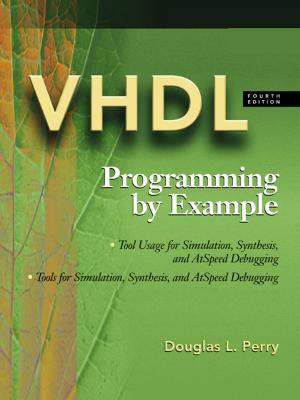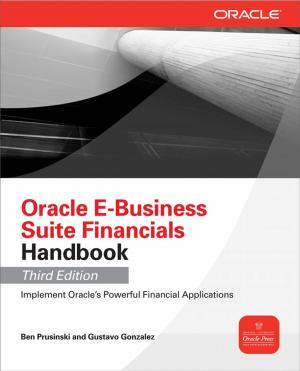Equity Valuation for Analysts and Investors
Business & Finance, Finance & Investing, Investments & Securities| Author: | James Kelleher | ISBN: | 9780071759526 |
| Publisher: | Mcgraw-hill | Publication: | June 16, 2010 |
| Imprint: | Language: | English |
| Author: | James Kelleher |
| ISBN: | 9780071759526 |
| Publisher: | Mcgraw-hill |
| Publication: | June 16, 2010 |
| Imprint: | |
| Language: | English |
Create comprehensive stock valuation models--quickly and efficiently
"This amazingly thorough book takes you through real-world financial modeling, provides concise techniques and methods for determining asset value, and offers a blended valuation approach that is responsive to changes in market dynamics. Peer Derived Value, introduced in the book, represents an original and commonsense approach to valuing a stock within its peer group. This book, in my view, is an invaluable addition to any investor's library." -- William V. Campbell, Chairman, Intuit Corporation
Equity Valuation for Analysts and Investors introduces you to the financial statement analysis and model-building methodology used by leading equity research firm Argus Research. Written by Jim Kelleher, the company's director of research, the book offers the tools for estimating individual equity cash value. These include a completely original and proprietary valuation methodology, Peer Derived Value, which values an equity based on the stock's current variation from its historical relation to a user-specifi ed peer group.
In a conveniently organized format, this in-depth guide covers all the tasks you need to master, including:
• Financial statement modeling • Comparables analysis • Discounted free cash fl ow • Industry matrix models • Blending valuation inputs to calculate fair value in any market environment
Valuing and predicting the future value of assets and stocks is a laborious task. Successful analysts and investors don't have time for tedious work that is outdated as soon as it's done.
Equity Valuation for Analysts and Investors is the comprehensive guide to efficient financial statement analysis and model-building from one of the world-leading independent equity research firms, Argus Research.
At the helm of the company's research is author Jim Kelleher, who developed his methodology and model-building techniques during his twenty years covering more than a dozen industries in nearly every sector. A good valuation model is an invaluable tool to help the serious investor:
- Wring more information from the 10-K and 10-Q
- Predict unexpected earnings shortfall or positive earnings surprises
- Master the art of "valuation choreography"
One of the biggest challenges to making accurate predictions with a valuation model today is the rapid and constant fluctuation of data. Equity Valuation for Analysts and Investors provides a tried-and-true process for creating effective, compact models that add new measurement and valuation periods and accommodate a company’s unique data presentation and reporting style.
This versatile guidebook also provides both a rigorous process and a shortcut for each step in modeling financial statement data so analysts can customize their data focus based on their position in the value chain. When implemented in the real world, the valuation model uses the power of Excel to allow investors to quickly and accurately update their valuations and predictions by simply inputting adjusted data.
Take control of your investments now by managing them based on your own research and Equity Valuation for Analysts and Investors.
Create comprehensive stock valuation models--quickly and efficiently
"This amazingly thorough book takes you through real-world financial modeling, provides concise techniques and methods for determining asset value, and offers a blended valuation approach that is responsive to changes in market dynamics. Peer Derived Value, introduced in the book, represents an original and commonsense approach to valuing a stock within its peer group. This book, in my view, is an invaluable addition to any investor's library." -- William V. Campbell, Chairman, Intuit Corporation
Equity Valuation for Analysts and Investors introduces you to the financial statement analysis and model-building methodology used by leading equity research firm Argus Research. Written by Jim Kelleher, the company's director of research, the book offers the tools for estimating individual equity cash value. These include a completely original and proprietary valuation methodology, Peer Derived Value, which values an equity based on the stock's current variation from its historical relation to a user-specifi ed peer group.
In a conveniently organized format, this in-depth guide covers all the tasks you need to master, including:
• Financial statement modeling • Comparables analysis • Discounted free cash fl ow • Industry matrix models • Blending valuation inputs to calculate fair value in any market environment
Valuing and predicting the future value of assets and stocks is a laborious task. Successful analysts and investors don't have time for tedious work that is outdated as soon as it's done.
Equity Valuation for Analysts and Investors is the comprehensive guide to efficient financial statement analysis and model-building from one of the world-leading independent equity research firms, Argus Research.
At the helm of the company's research is author Jim Kelleher, who developed his methodology and model-building techniques during his twenty years covering more than a dozen industries in nearly every sector. A good valuation model is an invaluable tool to help the serious investor:
- Wring more information from the 10-K and 10-Q
- Predict unexpected earnings shortfall or positive earnings surprises
- Master the art of "valuation choreography"
One of the biggest challenges to making accurate predictions with a valuation model today is the rapid and constant fluctuation of data. Equity Valuation for Analysts and Investors provides a tried-and-true process for creating effective, compact models that add new measurement and valuation periods and accommodate a company’s unique data presentation and reporting style.
This versatile guidebook also provides both a rigorous process and a shortcut for each step in modeling financial statement data so analysts can customize their data focus based on their position in the value chain. When implemented in the real world, the valuation model uses the power of Excel to allow investors to quickly and accurately update their valuations and predictions by simply inputting adjusted data.
Take control of your investments now by managing them based on your own research and Equity Valuation for Analysts and Investors.















